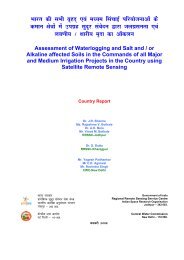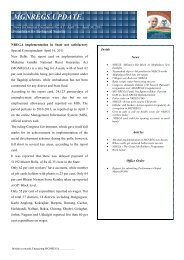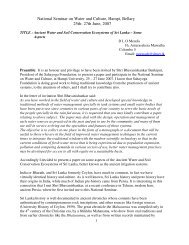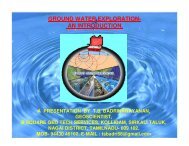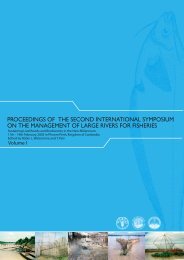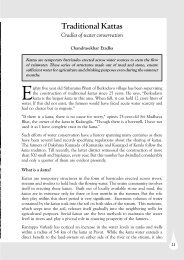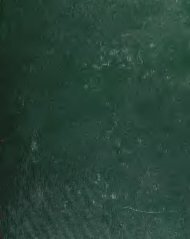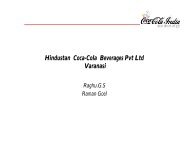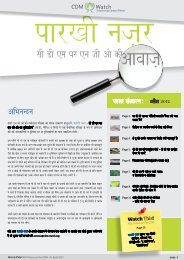Report - Assam: State Geology and Mineral Maps - India Water Portal
Report - Assam: State Geology and Mineral Maps - India Water Portal
Report - Assam: State Geology and Mineral Maps - India Water Portal
Create successful ePaper yourself
Turn your PDF publications into a flip-book with our unique Google optimized e-Paper software.
16 GEOLOGICAL SURVEY OF INDIA<br />
GSI Misc. Pub. 30 Pt. 4 Vol. 2(i)<br />
of Maibong <strong>and</strong> further northeastward upto Lumding.<br />
These rocks further continue northwards <strong>and</strong> are exposed<br />
in the south-eastern part of the Karbi (Mikir) Hills, as a<br />
narrow strip over the eastern base of the Karbi Hills. These<br />
rocks overlap the older horizons like Kopili, Sylhet limestone<br />
<strong>and</strong> metamorphite. The Bokabil Formation includes<br />
soft micaceous s<strong>and</strong>stone, siltstone, shale <strong>and</strong> clay with<br />
occasional intercalation of limestone <strong>and</strong> fossil wood.<br />
Shale samples collected from south of Khumbaman Parbat<br />
yielded a moderate assemblage of pteridophytic spore <strong>and</strong><br />
some angiospermic pollen, which indicate an age range<br />
from Oligocene to Miocene.<br />
Surma Group in Upper <strong>Assam</strong> is represented by<br />
about 30 to 60 m thick estuarine s<strong>and</strong>stone, shale <strong>and</strong> conglomerate<br />
unconformably overlying the Barails. Elsewhere<br />
the group is missing either due to overlap or by lateral passage<br />
of Bokabils into overlying Tipam Group which directly<br />
rests over the Barails in the Dilli-Jaipore <strong>and</strong> Makum<br />
coalfield areas.<br />
(a) Bhuban Formation:<br />
Bhuban Formation consists of s<strong>and</strong>stones, s<strong>and</strong>y<br />
shales <strong>and</strong> conglomerate intervened by shale, s<strong>and</strong>y shale<br />
<strong>and</strong> lenticular s<strong>and</strong>stone.<br />
The fossil fauna in Bhuban Formation is extremely<br />
rare. Sale (1932) <strong>and</strong> Sale <strong>and</strong> Evans (1940) reported occurrence<br />
of molluscan fauna namely Bassilia, Cancellaria,<br />
Hipponyx, Isocardia, Scutus, etc, in Early Miocene in<br />
Kanchanpur. Biswas (1961) assigned Middle Miocene age<br />
on the basis of a few foraminifera exposed in Halflong-<br />
Dulu-Damchar area. Pascoe (1962), however, assigned<br />
Chattian age to the Kanchanpur fauna.<br />
The palyno-fossil assemblage of the Bhuban Formation<br />
includes the following taxa:<br />
Dicolpollis emineus, Marginipollis gr<strong>and</strong>is, Tricolpites<br />
oratus, Favitricolporites usitatus, Oudhkusumites immodicus,<br />
Couperipollis, duratus, Hexapollentes artificiosus,<br />
Fusiformisporites adrogans, etc (Salujha et al, 1973)<br />
(b) Bokabil Formation:<br />
Bokabil Formation consists of shale, s<strong>and</strong>y shale,<br />
siltstone, mudstone <strong>and</strong> fairly thick lenticular, coarse<br />
grained, ferruginous s<strong>and</strong>stone. The s<strong>and</strong>-shale ratio frequently<br />
varies laterally <strong>and</strong> the Bokabil facies represents a<br />
gradational passage from the Bhuban Formation to the<br />
overlying Tipam S<strong>and</strong>stone Formation (Upper Miocene).<br />
At Kanchanpur near Silchar in Cachar district, a thin<br />
fossilliferous horizon occurs at the base of Bokabil Formation.<br />
The marine fauna assemblage mainly comprises<br />
of lamellibranch, gastropod, cirrpidia, actinozoa & echinoids<br />
which assigns Lower Miocene (Aquitanian) age to this<br />
formation.<br />
(K) TIPAM GROUP :<br />
Tipam Group comprises a lower arenaceous facies<br />
Tipam S<strong>and</strong>stone Formation <strong>and</strong> an upper argillaceous<br />
facies Girujan Clay Formation. Tipam Group has a general<br />
strike of ENE–WSW with a northerly dip varying<br />
from 50º-70º.<br />
The rocks of Tipam Group are exposed in many areas<br />
in the Surma valley. Upper part of the Tipam sequence<br />
at many places is found to be eroded away, prior to the<br />
deposition of overlying Dupitila Group. However,<br />
Girujan Clay is exposed in the hills between Chargola <strong>and</strong><br />
Longai valleys <strong>and</strong> the low hills to the east of Jatinga <strong>and</strong><br />
Cachar district. Rocks of this group are present also in<br />
the Labak-Diksha <strong>and</strong> Darby-Dwarb<strong>and</strong> areas.<br />
In <strong>Assam</strong> valley, Tipam Group occupies a 300 km<br />
long strip from Langting to Digboi interrupted by small<br />
patches of alluvium cover.<br />
Both Tipam <strong>and</strong> underlying Surma Groups include<br />
fragments of silicified <strong>and</strong> semi carbonised fossil wood.<br />
Tipam Group also includes several oil-s<strong>and</strong> horizons in<br />
Upper <strong>Assam</strong>. Along the northern border of the state, facing<br />
the southern foothills of eastern Himalayas, light greyish,<br />
fine to coarse, micaceous s<strong>and</strong>stone having a typical<br />
“pepper <strong>and</strong> salt” texture with thin beds of shale are exposed<br />
below the terrace deposits. The group designated<br />
as Subamgiri Formation of Siwalik Group is equivalent<br />
to Tipam Group. These s<strong>and</strong>stones are invariably associated<br />
with fragments of semi silicified, semi carbonised<br />
fossil wood, with minor seams of lignite <strong>and</strong> rarely with<br />
thin impersistent layers of pebble. The shale is rarely<br />
carbonaceous. The Siwalik beds are well exposed in



